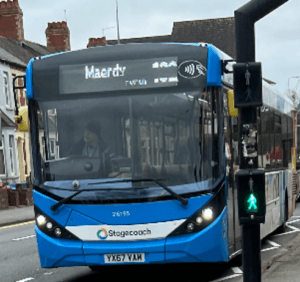Bus travel is set to change in Stoke-on-Trent with lower fares and new roads as part of a £90 million plan.
Stoke-on-Trent City Council has worked with operators to draw up the bus service improvement plan, with which they hope to secure a share of government funding,
Even before Covid-19, bus travel in the city had been declining for years, with patronage falling faster than nearly everywhere else in the country, reports Stoke-on-Trent Live.
The plan, which seeks to reverse this trend, includes proposals for major infrastructure improvements, such as the long-awaited completion of the city centre ring road and upgrades to existing routes such as Bucknall Road and Etruria Road.
But government funding is also requested for increasing services, especially during evenings and weekends, as well as lower and simpler fares, and improved information for passengers.
And the council wants all bus services in the city, currently run by a number of different operators, to have a common identity and branding, with multi-operator tickets to become the default.
As a first step, the plan asks for funding to allow bus companies in the city to continue running services at their current level once the Government’s emergency Covid-19 Bus Recovery Grant ends in April next year. The rest of the proposals would then be delivered over the next five years.
How much of the plan is eventually carried out will depend on Stoke-on-Trent’s allocation from the national ‘Bus Back Better’ funding pot, to be announced in the coming months.
Council chiefs secured £29 million for public transport improvements from the Government’s Tranforming Cities Fund last year. But last week, a £17.5 million bid to the Levelling Up Fund, which included similar ideas to the bus improvement plan, was unsuccessful.
Dan Jellyman, cabinet member for regeneration and transport at the city council, said: “We have been ambitious – we’ve deliberately taken a ‘go big or go home’ approach to this. On a per capita basis, we’d expect to get around £11 million from the £3 billion pot, but if we put in a bid in for just £11 million we might not even get that.
“It works out as about £100, per person for each of the three years. So that’s what we’re saying is needed to improve bus travel in Stoke-on-Trent.https://www.inyourarea.co.uk/widgets/established/localIssues?fixedheight&webreachnews&theme=stokesentinel
“We’re telling Government that we have a greater need for this funding than most other areas. Stoke-on-Trent has seen a faster decline in bus patronage over the last 10 years than anywhere else in the country apart from Warrington. So we’ve got a lot of work to do just to get to where we were 10 years ago, before we can think about improving on that.”
Between 2010 and 2020 – predating the pandemic – the number of bus journeys per head of population in Stoke-on-Trent fell by almost 50 per cent, from 63.9 to 32.9. Across the West Midlands, the average number of journeys dropped from 72.2 to 50.5 – a decline of just 30 per cent.
The Stoke-on-Trent bus improvement plan includes the following proposals:
- Funding to increase services, including more frequent buses and later services in the evening and on Sundays;
- Bus priority measures to help buses run on time, including a system to give buses priority at traffic lights;
- Major road building schemes to enable road space to be allocated for bus priority on main bus corridors, including Bucknall Road, Etruria Road, Waterloo Road, and Trubshaw Cross, Longport;
- Lower and simpler fares, including the same age cap of young person fares across all operators and a multi-operator fare cap that guarantees a maximum daily fare regardless of the operator/services used;
- Integrated bus-rail fares within the North Staffordshire area;
- Network identity and branding applied to all buses, information, and infrastructure, with multi-operator tickets becoming the default;
- Improved information for passengers at bus stops and on buses;
- A joint Bus Passenger Charter to be agreed by the city council, bus operators and bus user groups, to ensure excellent customer service;
- And improved access and safety measures, including raised kerbs at more stops, CCTV on buses, and CCTV and improved lighting at key bus stops.
Around two-thirds of the £90 million would cover infrastructure improvements, such as the new roads – which would obviously benefit car drivers as much, if not more than bus passengers.






















